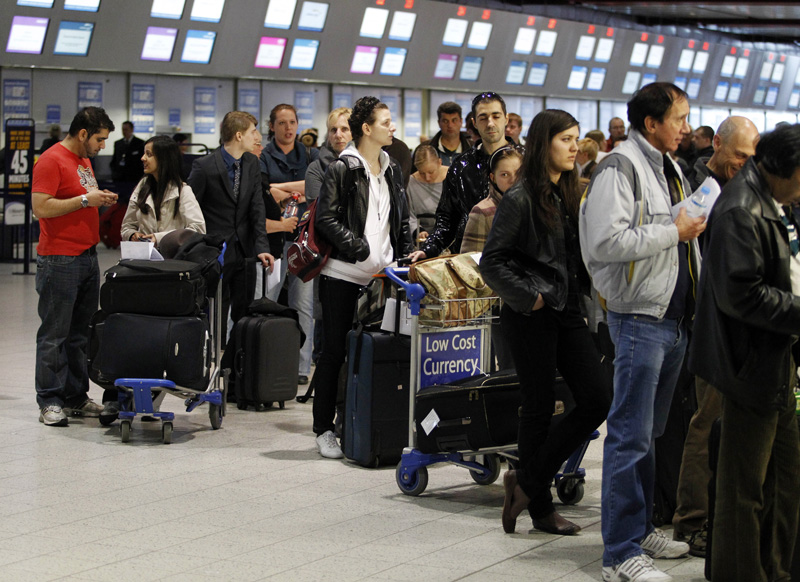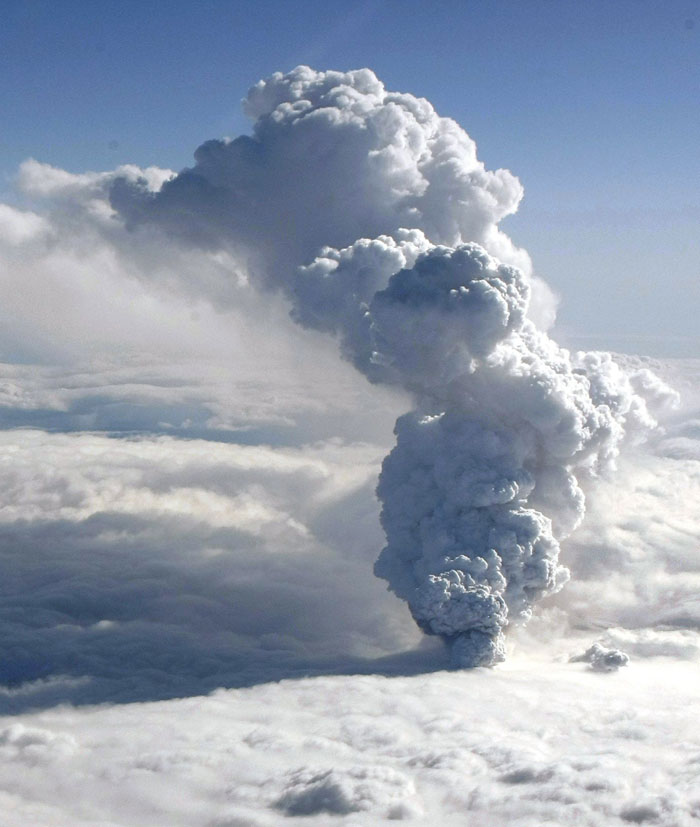LONDON — Ash clouds from Iceland’s spewing volcano halted air traffic across a wide swathe of Europe today, grounding planes on a scale unseen in years, as authorities stopped all flights over Britain, Ireland and the Nordic countries.
Thousand of flights were canceled, stranding tens of thousands of passengers, and authorities said it was not clear when it would be safe enough to fly again.
One scientist in Iceland said the ejection of volcanic ash – and therefore possible disruptions in air travel – could continue for days or even weeks.
British civil aviation authorities say flights won’t start departing or arriving in Britain until at least 1 a.m. (0500 GMT) Friday.
A statement from the authority said the “cloud of volcanic ash is now spread across the U.K. and continuing to travel south.”
The move shut down London’s five major airports including Heathrow, a major trans-Atlantic hub that handles over 1,200 flights and 180,000 passengers per day. Shutdowns and cancellations spread to France, Belgium, the Netherlands, Denmark, Ireland, Sweden, Finland and Switzerland.
The volcano’s smoke and ash poses a threat to aircraft because it can affect visibility, and microscopic debris can get sucked into airplane engines and can cause them to shut down.
It was not the first time air traffic has been halted by a volcano, but such widespread disruption had not been seen since a trans-Atlantic terror alert in 2006.
The National Air Traffic Service said all flights in British air space had not been halted in living memory, although most flights were grounded after the Sept. 11, 2001 attacks. Heathrow was also closed by fog for two days in 1952.
In Iceland, hundreds of people have fled rising floodwaters since the volcano under the Eyjafjallajokull (ay-yah-FYAH’-plah-yer-kuh-duhl) glacier erupted Wednesday for the second time in less than a month. As water gushed down the mountainside, rivers rose up to 10 feet (3 meters) by Wednesday night, slicing the island nation’s main road in half.
The volcano still spewed ash and steam Thursday, but the floods had subsided. Some ash was falling on uninhabited areas, but most was being blown by westerly winds toward northern Europe, including Britain, about 1,200 miles (2,000 kilometers) away.
“It is likely that the production of ash will continue at a comparable level for some days or weeks. But where it disrupts travel, that depends on the weather,” said Einar Kjartansson, a geophysicist at the Icelandic Meteorological Office. “It depends how the wind carries the ash”
In Paris, all flights north were canceled until midnight. At Copenhagen’s international airport, spokesman Henrik Peter Joergensen said some 25,000 passengers were affected.
“At the present time it is impossible to say when we will resume flying,” Joergensen said.
Passengers found themselves looking up at departure boards where every flight was canceled.
“I just wish I was on a beach in Mexico,” said Ann Cochrane, 58, of Toronto, a passenger stranded in Glasgow.
“It’s so ridiculous it is almost amusing,” said Cambridge University researcher Rachel Baker, 23, who had planned to meet her American boyfriend in Boston but got no farther than Heathrow.
The U.S. Geological Survey says about 100 aircraft have run into volcanic ash from 1983 to 2000. In some cases engines shut down briefly after sucking in volcanic debris, but there have been no fatal incidents.
Kjartansson said until the 1980s, airlines were less cautious about flying through volcanic clouds.
“There were some close calls and now they are being more careful,” he said.
In 1989, a KLM Royal Dutch Airlines Boeing 747 flew into an ash cloud from Alaska’s Redoubt volcano and lost all power, dropping from 25,000 feet to 12,000 feet (7,500 meters to 3,600) before the crew could get the engines restarted. The plane landed safely.
In another incident in the 1980s, a British Airways 747 flew into a dust cloud and the grit sandblasted the windscreen. The pilot had to stand and look out a side window to land safely.
The ash cloud has not disrupted operations at Iceland’s Keflavik airport or caused problems in the capital of Reykjavik, but has affected the southeastern part of the island, said meteorologist Thorsteinn Jonsson. In one area, visibility was reduced to 150 meters (yards) today, he said, and farmers were advised to keep livestock indoors to protect them from eating the abrasive ash.
Last month’s eruption at the same volcano occurred in an area where there was no glacial ice – lessening the overall risk. Wednesday’s eruption, however, occurred beneath a glacial cap. If the eruption continues, and there is a supply of cold water, the lava will chill quickly and fragment into glass.
If the volcano keeps erupting, it could cause massive flight disruptions.
“When there is lava erupting close to very cold water, the lava chills quickly and turns essentially into small glass particles that get carried into the eruption plume,” said Colin Macpherson, a geologist with the University of Durham. “The risk to flights depends on a combination of factors — namely whether the volcano keeps behaving the way it has and the weather patterns.”
Send questions/comments to the editors.




Success. Please wait for the page to reload. If the page does not reload within 5 seconds, please refresh the page.
Enter your email and password to access comments.
Hi, to comment on stories you must . This profile is in addition to your subscription and website login.
Already have a commenting profile? .
Invalid username/password.
Please check your email to confirm and complete your registration.
Only subscribers are eligible to post comments. Please subscribe or login first for digital access. Here’s why.
Use the form below to reset your password. When you've submitted your account email, we will send an email with a reset code.